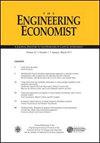Average internal rate of return for risky projects
IF 1
4区 经济学
Q4 BUSINESS
引用次数: 9
Abstract
Abstract The average internal rate of return (AIRR) fixes many deficiencies associated with the traditional internal rate of return (IRR), including apparent inconsistency with net present value (NPV). The AIRR approach breaks down project NPV into scale (the capital invested) and economic efficiency (the AIRR), and maintains NPV consistency for accept/reject decisions. Here we examine extensions of the AIRR to risky capital asset projects, a domain where the IRR appears intractable. We show that one can uniquely break down a risky NPV into a risk-sensitive project scale and a risk-sensitive extended AIRR, representing risky project efficiency, so that consistency with NPV for accept/reject decisions is maintained in the certainty-equivalent sense, in direct analogy to the deterministic case. This novel breakdown gives managerial insight by helping determine a risky project’s locus of uncertainty, be it the project scale, or economic efficiency, or both. In this way, risky features of competing projects can be explored in more detail, leading to insights substantiating the NPV ranking. We also show that under risk neutrality, the expected AIRR is equal to the AIRR of the expected cash flow, a property that notoriously fails for the stochastic IRR.风险项目的平均内部收益率
摘要平均内部收益率(AIRR)弥补了传统内部收益率的许多不足,包括与净现值(NPV)明显不一致。AIRR方法将项目NPV分解为规模(投资资本)和经济效率(AIRR),并保持接受/拒绝决策的NPV一致性。在这里,我们研究了AIRR对风险资本资产项目的扩展,这是一个IRR似乎难以处理的领域。我们证明,可以将风险NPV唯一地分解为风险敏感的项目规模和风险敏感的扩展AIRR,代表风险项目效率,从而在确定性等价意义上保持接受/拒绝决策与NPV的一致性,直接类似于确定性情况。这种新颖的细分通过帮助确定风险项目的不确定性来源,无论是项目规模还是经济效率,或两者兼而有之,提供了管理洞察力。通过这种方式,可以更详细地探索竞争项目的风险特征,从而获得证实NPV排名的见解。我们还表明,在风险中性下,预期AIRR等于预期现金流的AIRR,这是一个众所周知的随机IRR失败的性质。
本文章由计算机程序翻译,如有差异,请以英文原文为准。
求助全文
约1分钟内获得全文
求助全文
来源期刊

Engineering Economist
ENGINEERING, INDUSTRIAL-OPERATIONS RESEARCH & MANAGEMENT SCIENCE
CiteScore
2.00
自引率
0.00%
发文量
14
审稿时长
>12 weeks
期刊介绍:
The Engineering Economist is a refereed journal published jointly by the Engineering Economy Division of the American Society of Engineering Education (ASEE) and the Institute of Industrial and Systems Engineers (IISE). The journal publishes articles, case studies, surveys, and book and software reviews that represent original research, current practice, and teaching involving problems of capital investment.
The journal seeks submissions in a number of areas, including, but not limited to: capital investment analysis, financial risk management, cost estimation and accounting, cost of capital, design economics, economic decision analysis, engineering economy education, research and development, and the analysis of public policy when it is relevant to the economic investment decisions made by engineers and technology managers.
 求助内容:
求助内容: 应助结果提醒方式:
应助结果提醒方式:


